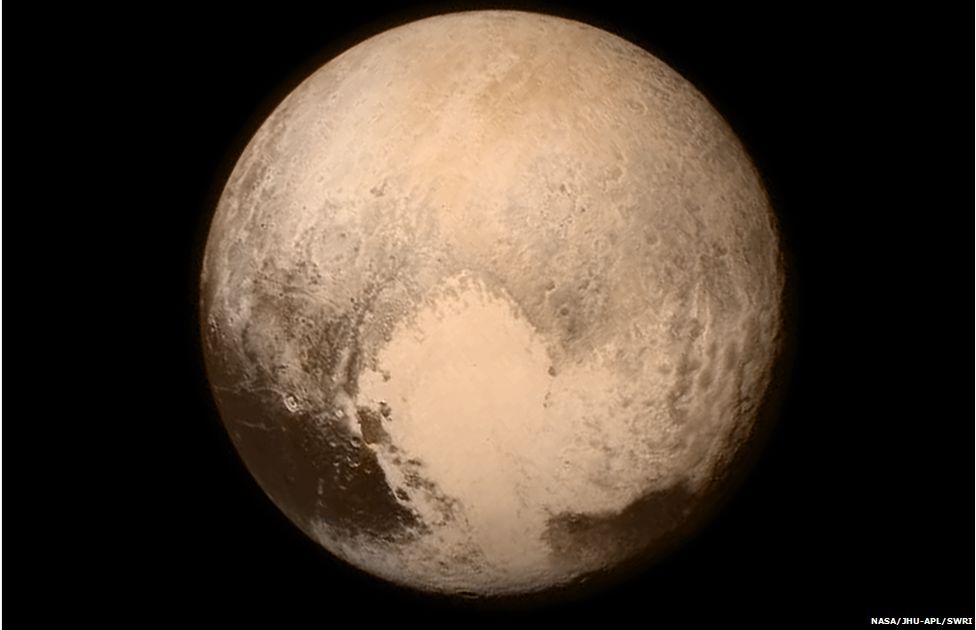New Horizons: Nasa spacecraft speeds past Pluto
- Published

Nasa's New Horizons spacecraft has made the first visit to Pluto, speeding past at 14km per second.
Earlier, the space agency released the most detailed picture yet as it hurtled towards the dwarf planet on Tuesday.
The probe was set to grab more images and other data as it passed just 12,500km from the little world at 11:50 GMT (12:50 BST).
The spacecraft is currently out of contact with Earth as it continues its observations.
But scientists already have colour data from the approach and said they might release another new picture of Pluto later on Tuesday.
Images set to be released on Wednesday will be more than 10 times the resolution of those already published.
New Horizons' flyby of 2,370km-wide Pluto is a key moment in the history of space exploration.
It marks the fact that all nine objects considered by many to be the Solar System's planets - from Mercury through to Pluto - have now been visited at least once by a probe.
"We have completed the initial reconnaissance of the Solar System, an endeavour started under President Kennedy more than 50 years ago and continuing to today under President Obama," said the mission's chief scientist, Alan Stern.
"It's really historic what the US has done, and the New Horizons team is really proud to have been able to run that anchor leg and make this accomplishment."
Talking about the main image of Pluto that was returned just before the flyby began, Nasa's science chief, John Grunsfeld, said: "This is true exploration... that view is just the first of many rewards the team will get. Pluto is an extraordinarily complex and interesting world."
The information that has been acquired in recent weeks on approach to the dwarf world will be as nothing to the huge number of observations captured during the flyby. But scientists have already been attempting to interpret the data and images so far.
Dr Stern said: "On the surface we see a history of impacts, we see a history of surface activity in terms of some features we might be able to interpret as tectonic - indicating internal activity on the planet at some point in its past, and maybe even in its present.
"This is clearly a world where geology and atmosphere - climatology - play a role. Pluto has strong atmospheric cycles. It snows on the surface. These snows sublimate - (and) go back into the atmosphere - every 248-year orbit."
The team also released two stretched colour images, of Pluto and its main moon, Charon. The treatment allows scientists to discern more easily some of the differences at the surface of the bodies in terms of composition and processing.
New Horizons is investigating not only Pluto and Charon, but also the four smaller moons in the system: Styx, Nix, Kerberos and Hydra.
To achieve that, it has had to perform a furious set of manoeuvres during the flyby, pointing every which way in the sky to lock on to the different targets.
Analysis - David Shukman
The cheering and jubilation are phenomenal. There's a powerful sense of achievement at sending a robotic craft three billion miles to Pluto. But there's also something much more instinctive: the thrill of witnessing and sharing a great moment of discovery.
Most moving for me has been catching a few words with the son of the man who first found Pluto. Al Tombaugh is obviously delighted that a sample of his father Clyde's ashes is on board New Horizons, speeding past Pluto and now heading into the unexplored realm of the Kuiper Belt.
I asked Al if his father would have wanted to visit the tiny world. Maybe, he said, but he was always worried about the physical strain of life as an astronaut. Another thought that's very striking here today: so many scientists and engineers and technicians have had a hand in making this mission work, and their excitement is totally justified.
So what about the coming hours? No one here will truly relax until the next signals reach home as the spacecraft slips beyond Pluto.
New Horizons' call home after the flyby is due at 00:53 GMT Wednesday (01:53 BST). It will come through a giant dish in Madrid, Spain - part of Nasa's Deep Space Network of communications antennas.
This signal will contain only engineering information on the status of the probe, but controllers should be able to tell very quickly whether the flyby sequence worked properly or not.
There is a very small possibility that New Horizons could be lost as it flies through the Pluto system.
Any stray icy debris would have been lethal if it had collided with the spacecraft at its 14km/s velocity (31,000mph).
"Hopefully it did [survive]," said Alan Stern, "but there is a little bit of drama."
The first high-resolution pictures from the pass should be downlinked later on Wednesday.
The BBC will be screening a special Sky At Night programme called Pluto Revealed on Monday 20 July, which will recap all the big moments from the New Horizons flyby.
Follow Jonathan on Twitter
- Published10 July 2015
- Published14 July 2015
- Published13 July 2015
- Published13 July 2015
- Published11 July 2015
- Published11 July 2015
- Published9 July 2015
- Published9 July 2015
- Published8 July 2015
- Published6 July 2015
- Published2 July 2015
- Published1 July 2015
- Published12 June 2015